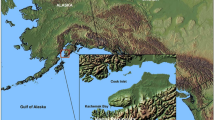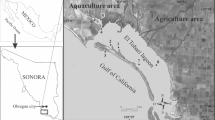Abstract
The influence of the Nyanza Chemical Waste Dump Superfund Site on the Sudbury River, Massachusetts, was assessed by analysis of sediment, fish prey organisms, and predator fish from four locations in the river system. Whitehall Reservoir is an impoundment upstream of the site, and Reservoir #2 is an impoundment downstream of the site. Cedar Street is a flowing reach upstream of the site, and Sherman Bridge is a flowing reach downstream of the site. Collections of material for analysis were made three times, in May, July, and October. Sediment was analyzed for acid-volatile sulfide (AVS), simultaneously-extracted (SEM) metals (As, Cd, Cr, Hg, Pb, Sb, Zn), and total recoverable Hg. The dominant predatory fish species collected at all sites, largemouth bass (Micropterussalmoides), was analyzed for the same suite of metals as sediment. Analysis of stomach contents of bass identified smallfish (yellow perch Perca flavescens, bluegill Lepomismacrochirus, and pumpkinseed Lepomis gibbosus), crayfish,and dragonfly larvae as the dominant prey organisms. Samples of the prey were collected from the same locations and at the sametimes as predator fish, and were analyzed for total and methyl mercury. Results of AVS and SEM analyses indicated that sediments were not toxic to aquatic invertebrates at any site. The SEM concentrations of As, Cd, and Cr were significantly higher at Reservoir #2 than at the reference sites, and SEM As and Cdwere significantly higher at Sherman Bridge than at Cedar St. Sediment total Hg was elevated only at Reservoir #2. Hg washigher at site-influenced locations in all fish speciesexcept brown bullhead (Ameiurus nebulosus). Cd washigher in bluegill, black crappie (Pomoxis nigromaculatus),and brown bullhead, and Cr was higher in largemouth bass filletsamples but not in whole-body samples. There were no seasonal differences in sediment or prey organism metals, but some metalsin some fish species did vary over time in an inconsistent manner. Predator fish Hg concentration was significantly linearlyrelated to weighted prey organism methyl Hg concentration. Largemouth bass Hg was significantly lower at Reservoir #2 in our study than in previous investigations in 1989 and 1990. High concentrations of inorganic Hg remain in river sediment asa result of operation of the Nyanza site, and fish Hg concentrations in river reaches downstream of the site areelevated compared to upstream reference sites. However, thedifferences are relatively small and Hg concentrations inlargemouth bass from the site-influenced locations are nohigher than those from some other, nearby uncontaminatedsites. We hypothesize that this results from burial ofcontaminated sediment with cleaner material, which reducesbioavailability of contaminants and possibly reducesmethylation of mercury.
Similar content being viewed by others

References
Allen, H., Fu, G. and Deng, B.: 1993, 'Analysis of acid-volatile sulfide (AVS) and simultaneously extracted metals (SEM) for the estimation of potential toxicity in aquatic sediments', Environ. Toxicol. Chem. 12, 1441-1453.
Ankley, G., Mattson, V., Leonard, E., West, C. and Bennett, J.: 1993, 'Predicting the acute toxicity of copper in freshwater sediments: Evaluation of the role of acid-volatile sulfide', Environ. Toxicol. Chem. 12, 315-320.
Ankley, G., Call, D., Cox, J., Kahl, M., Hoke, R. and Kosian, P.: 1994, 'Organic carbon partitioning as a basis for predicting the toxicity of chlorpyrifos in sediments', Environ. Toxicol. Chem. 13, 621-626.
Becker, D. and Bigham, G.: 1995, 'Distribution of mercury in the aquatic food web of Onondaga Lake, New York', Water, Air, Soil Pollut. 80, 563-571.
Bloom, N.: 1992, 'On the chemical form of mercury in edible fish and marine invertebrate tissue', Can. J. Fish. Aquat. Sci. 46, 1131-1140.
Brumbaugh, W., Ingersoll, C., Kemble, N., May, T. and Zajicek, J.: 1994, 'Chemical characterization of sediments and pore water from the Upper Clark Fork River and Milltown Reservoir, Montana', Environ. Toxicol. Chem. 13, 1971-1983.
Brumbaugh, W. and Arms, J.: 1996, 'Quality control considerations for the determination of acid-volatile sulfide and simultaneously-extracted metals in sediments', Environ. Toxicol. Chem. 15, 282-285.
Carlson, A., Phipps, G., Mattson, V., Kosian, P. and Cotter, A.: 1991, 'The role of acid-volatile sulfide in determining cadmium bioavailability and toxicity in freshwater sediments', Environ. Toxicol. Chem. 10, 1309-1319.
DiToro, D., Mahony, J., Hansen, D., Scott, K., Hicks, M., Mayer, S. and Redmond, M.: 1990, 'Toxicity of cadmium in sediments: The role of acid volatile sulfide', Environ. Toxicol. Chem. 9, 1487-1502.
DiToro, D., Mahony, J., Hansen, D., Scott, K., Carr, A. and Ankley, G.: 1992, 'Acid volatile sulfide predicts the acute toxicity of cadmium and nickel in sediments', Environ. Sci. Technol. 26, 96-101.
Francesconi, K. and Lenanton, R.: 1992, 'Mercury contamination in a semi-enclosed marine embayment: Organic and inorganic mercury content of biota, and factors influencing mercury levels in fish', Marine Environ. Res. 33, 189-212.
Hill, W., Stewart, A. and Napolitano, G.: 1996, 'Mercury speciation and bioaccumulation in lotic primary producers and primary consumers', Can. J. Fish. Aquat. Sci. 53, 812-819.
Ingersoll, C., Brumbaugh, W., Dwyer, F. and Kimble, N.: 1994, 'Bioaccumulation of metals by Hyalella azteca exposed to contaminated sediments from the Upper Clark Fork River, Montana', Environ. Toxicol. Chem. 13, 2013-2020.
Jackson, T.: 1991, 'Biological and environmental control of mercury accumulation by fish in lakes and reservoirs of northern Manitoba, Canada', Can. J. Fish. Aquat. Sci. 48, 2449-2470.
Johnson, J. and Dropkin, D.: 1995, 'An Analysis of Fish Diet Composition and the Benthic Invertebrate Community of the Sudbury River, Massachusetts', Final Report to U.S. Fish and Wildlife Service, May, 1995, 18 pp.
Kemble, N., Brumbaugh, W., Brunson, E., Dwyer, F., Ingersoll, C., Monda, D. and Woodward, D.: 1994, 'Toxicity of metal-contaminated sediments from the Upper Clark Fork River, Montana, to aquatic invertebrates and fish in laboratory exposures', Environ. Toxicol. Chem. 13, 1985-1997.
Lansens, P., Leermakers, M. and Baeyens, W.: 1991, 'Determination of methylmercury in fish by headspace gas chromatography with microwave-induced-plasma detection', Water, Air, Soil Pollut. 56, 103-115.
Lasorsa, B. and Allen-Gil, S.: 1995, 'The methylmercury to total mercury ratio in selected marine, freshwater, and terrestrial organisms', Water, Air, Soil Pollut. 80, 905-913.
Liang, L., Bloom, N. and Horvat, M.: 1994, 'Simultaneous determination of mercury speciation in biological materials by GC/CVAFS after ethylation and room-temperature precollection', Clin. Chem. 40, 602-607.
NUS Corporation: 1992, 'Final Remedial Investigation Report, Nyanza Operable Unit III-Sudbury River Study Middlesex County, Massachusetts', W92194F, NUS Corporation.
Parkman, H. and Meili, M.: 1993, 'Mercury in macroinvertebrates from Swedish forest lakes: Influence of lake type, habitat, life cycle, and food quality', Can. J. Fish. Aquat. Sci. 50, 521-534.
Parks, J., Sutton, J., Hollinger, J. and Russell, D.: 1988, 'Uptake of mercury by caged crayfish', Appl. Organometal. Chem. 2, 181-184.
Post, J., Vandenbos, R. and McQueen, D.: 1996, 'Uptake rates of food-chain and waterborne mercury by fish: Field measurements, a mechanistic model, and an assessment of uncertainties', Can. J. Fish. Aquat. Sci. 53, 395-407.
Rodgers, D.: 1994, 'You Are What You Eat and a Little Bit More: Bioenergetics-based Models of Methylmercury Accumulation in Fish Revisited', in C. Watrasa and J. Huckabee (eds), Mercury Pollution: Integration and Synthesis, Lewis Publishers, Boca Raton, FL, U.S.A., pp. 427-439.
Rose, J., Hutcheson, M., West, C., Pancorbo, O., Hulme, K., Cooperman, A., DeCesare, G., Isaac, R. and Screpetis, A.: 1999, 'Fish mercury distribution in Massachusetts, U.S.A. lakes', Environ. Toxicol. Chem. 18, 1370-1379.
SAS Institute, Inc.: 1989, SAS/STAT Users Guide, Version 6, 4th ed, SAS Institute, Inc., Cary, North Carolina.
Schmitt, C. and Brumbaugh, W.: 1990, 'National contaminant biomonitoring program: Concentrations of arsenic, cadmium, copper, lead, mercury, selenium, and zinc in U.S. freshwater fish, 1976-1984', Arch. Environ. Contam. Toxicol. 19, 731-747.
Southworth, G., Turner, R., Peterson, M. and Bogle, M.: 1995, 'Form of mercury in stream fish exposed to high concentrations of dissolved inorganic mercury', Chemosphere 30, 779-787.
Sowles, J., Mower, B., Davies, S. and Tsomides, L.: 1997, 'SurfaceWater Ambient Toxic Monitoring Program 1995', Technical Report, Maine Department of Environmental Protection, Augusta, Maine.
Spry, D. and Wiener, J.: 1991, 'Metal bioavailability and toxicity to fish in low-alkalinity lakes: A critical review', Environ. Pollut. 71, 243-304.
Stafford, C. and Haines, T.: 1997, 'Mercury concentration in Maine sport fishes', Trans. Am. Fish. Soc. 126, 144-152.
Tremblay, A., Lucotte, M. and Rheault, I.: 1996, 'Methylmercury in a benthic food web of two hydroelectric reservoirs and a natural lake of northern Quebec (Canada)', Water, Air, Soil Pollut. 91, 255-269.
Wiener, J. and Shields, P.: 1999, 'Mercury in the Sudbury River (Massachusetts, U.S.A.): Pollution history and a synthesis of recent research', Can. J. Fish. Aquat. Sci. 57, 1053-1061.
Winfrey, M. and Rudd, J.: 1990, 'Environmental factors affecting formation of methylmercury in low pH lakes', Environ. Toxicol. Chem 9, 853-869.
Winner, R. and Gauss, J.: 1986, 'Relationship between chronic toxicity and bioaccumulation of copper, cadmium and zinc as affected by water hardness and humic acid', Aquat. Toxicol. 8, 149-161.
Wong, A., McQueen, D. and Williams, D.: 1994, 'A Comparison of the Accumulation of Mercury Among 5 Species of Dragonfly Nymphs (Odonata)', Poster Presentation at Society of Environmental Toxicology and Chemistry Annual Meeting, Denver, Colorado.
Author information
Authors and Affiliations
Corresponding author
Rights and permissions
About this article
Cite this article
Haines, T.A., May, T.W., Finlayson, R.T. et al. Factors Affecting Food Chain Transfer of Mercury in the Vicinity of the Nyanza Site, Sudbury River, Massachusetts. Environ Monit Assess 86, 211–232 (2003). https://doi.org/10.1023/A:1024017329382
Issue Date:
DOI: https://doi.org/10.1023/A:1024017329382



